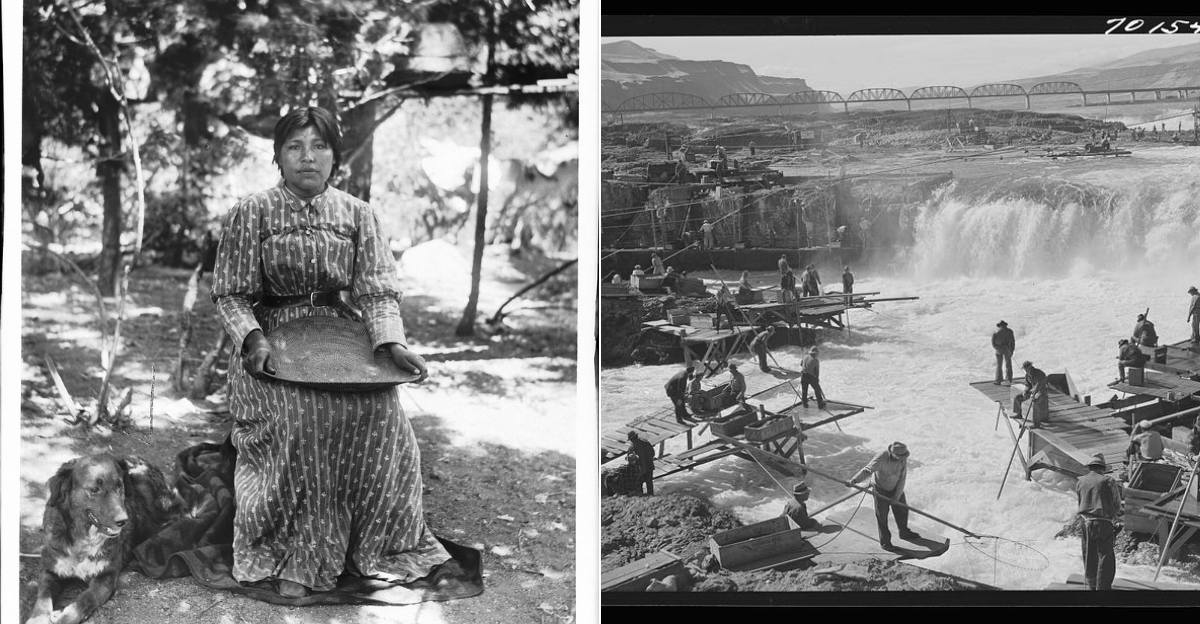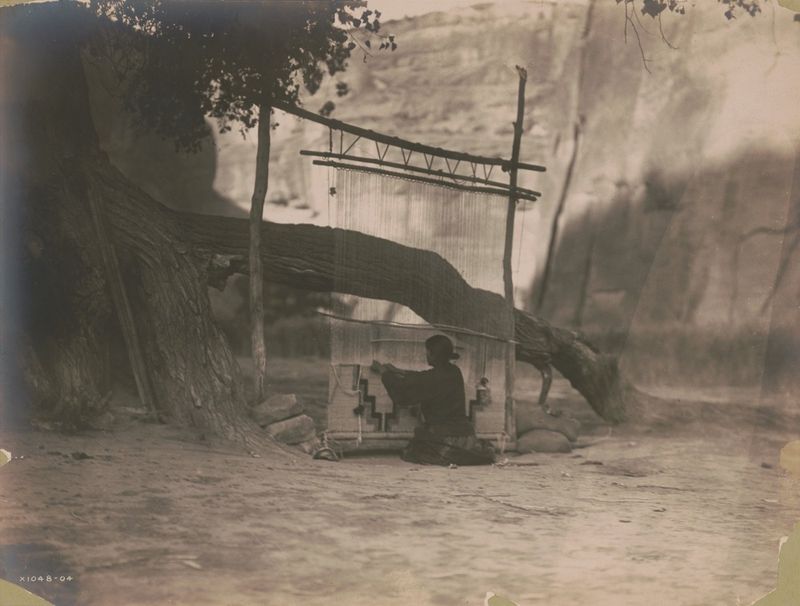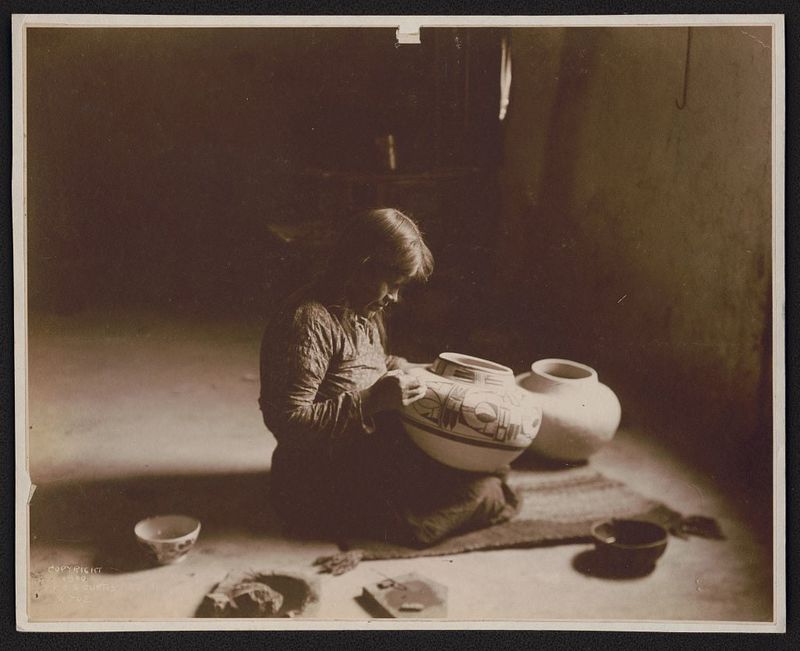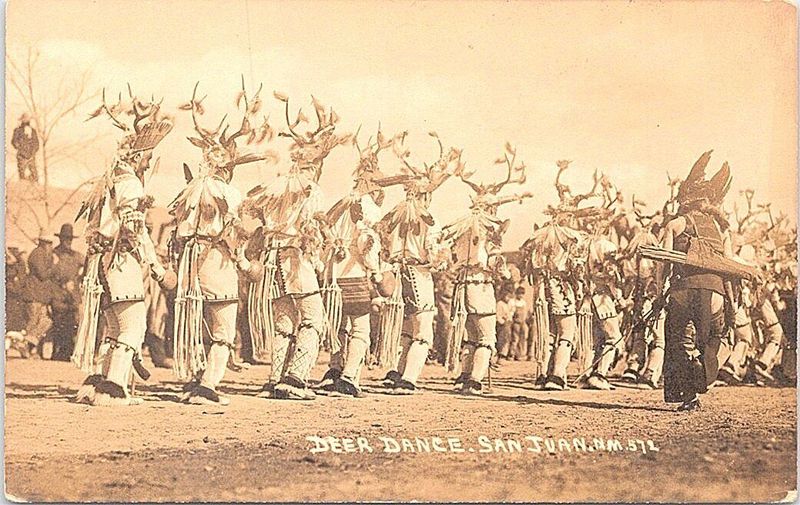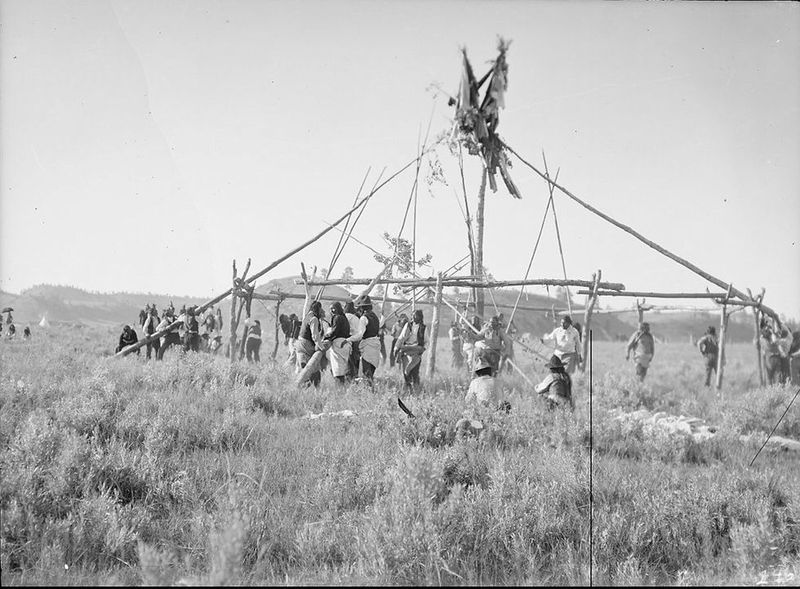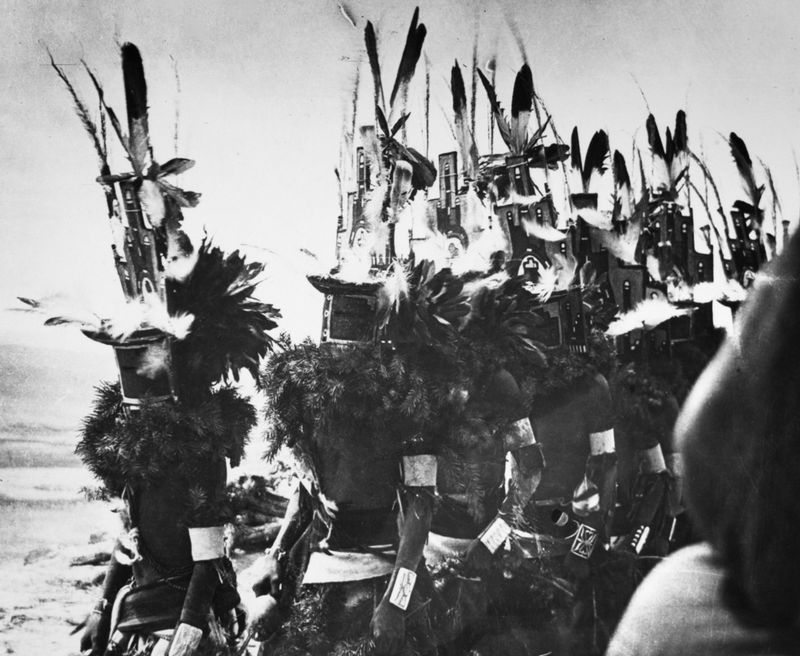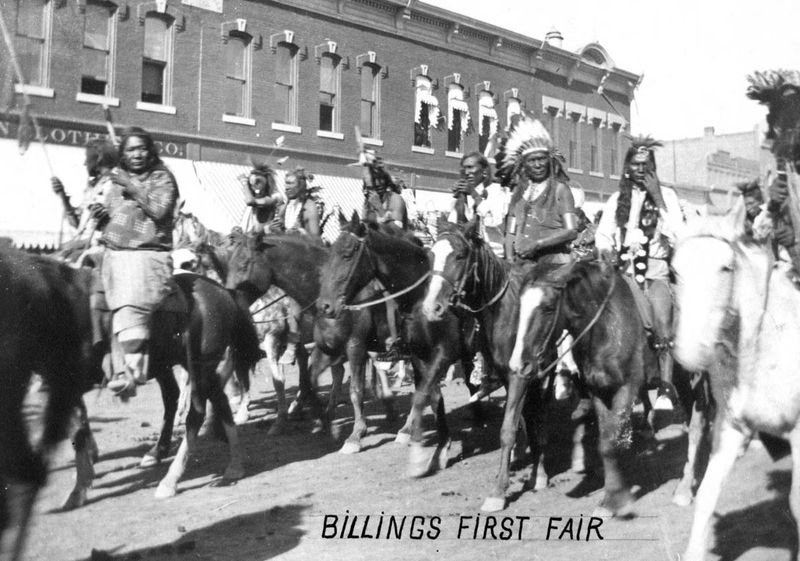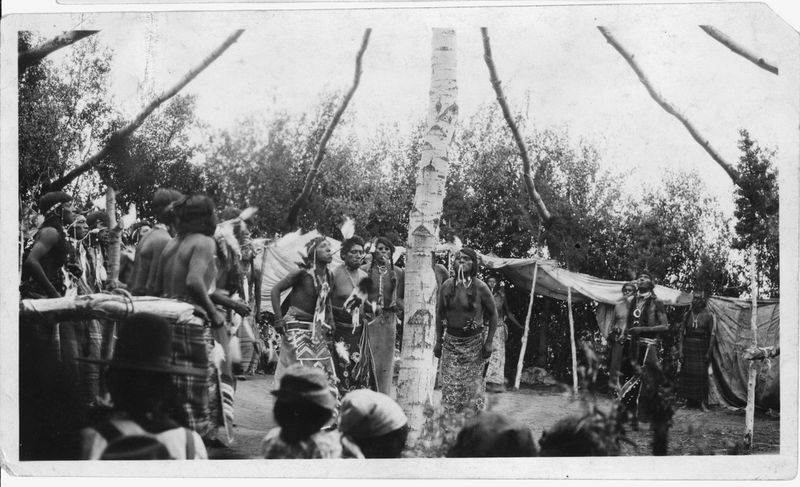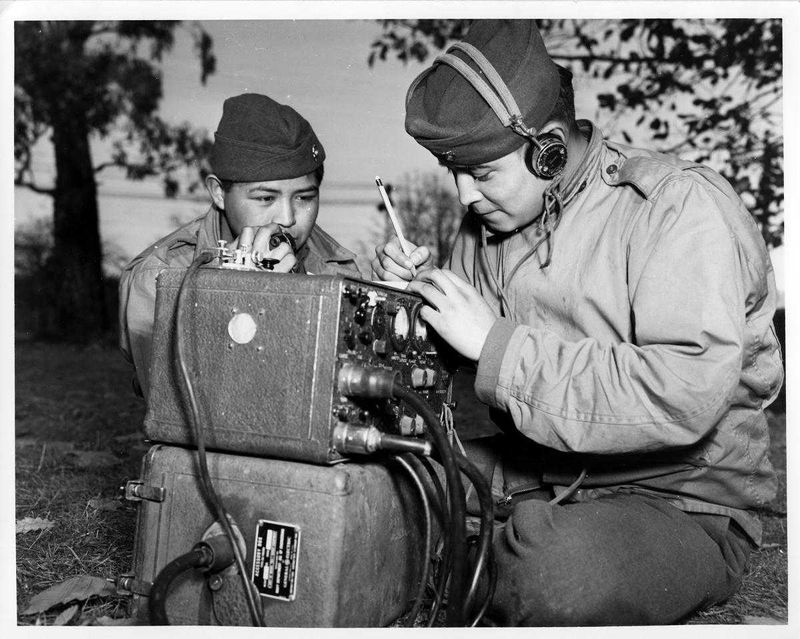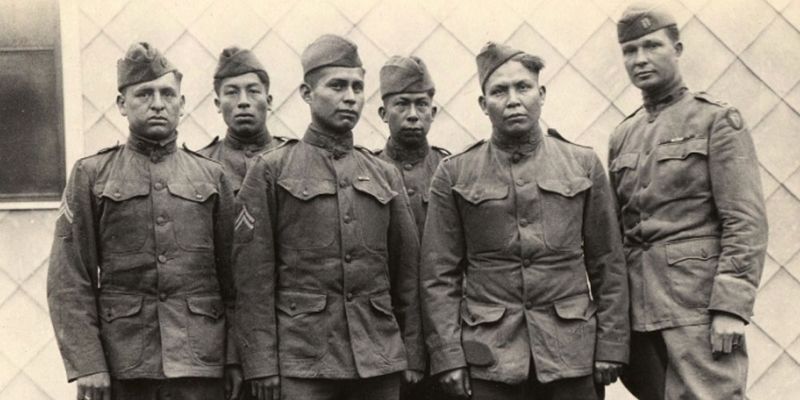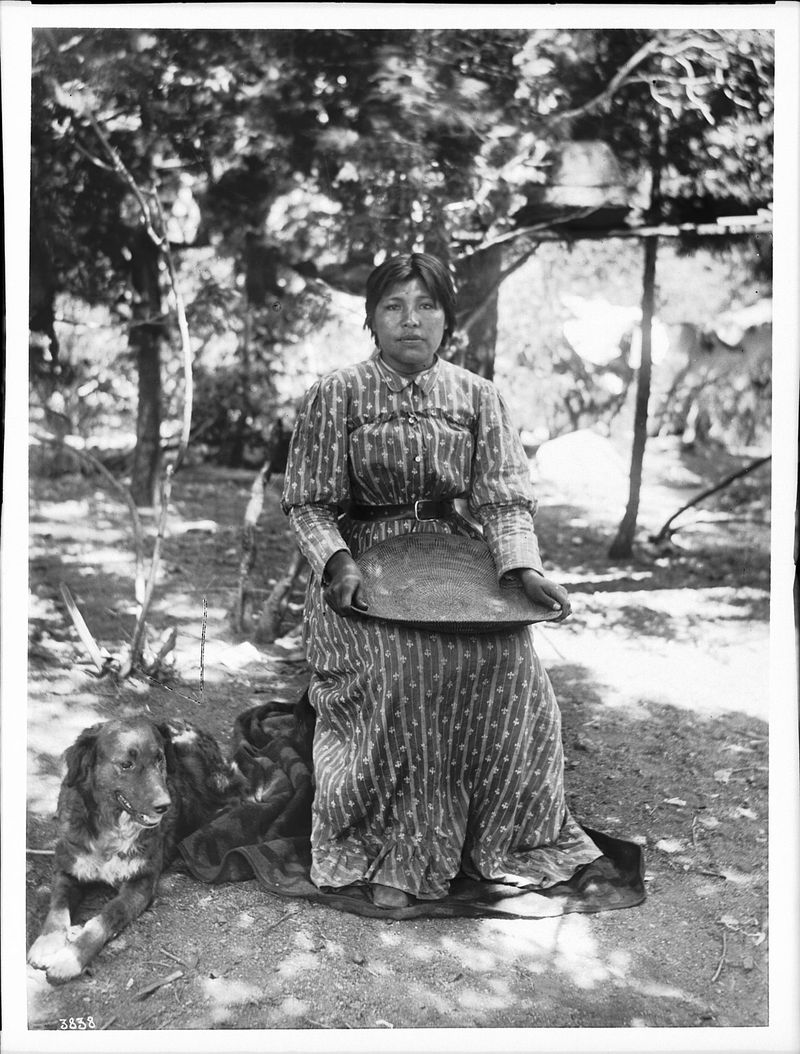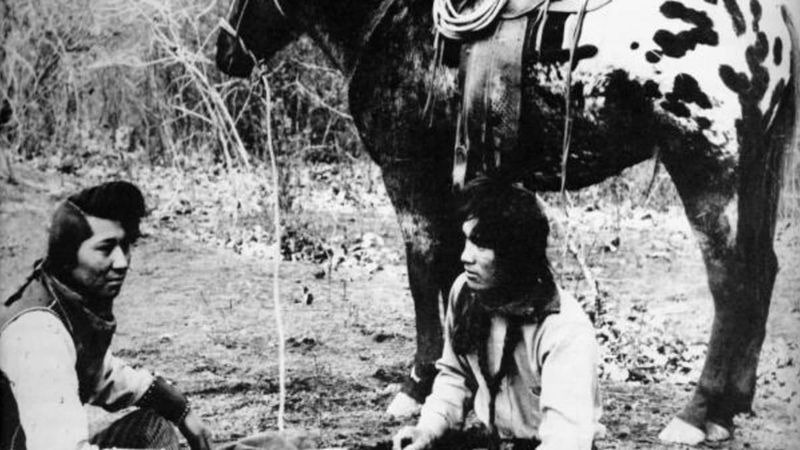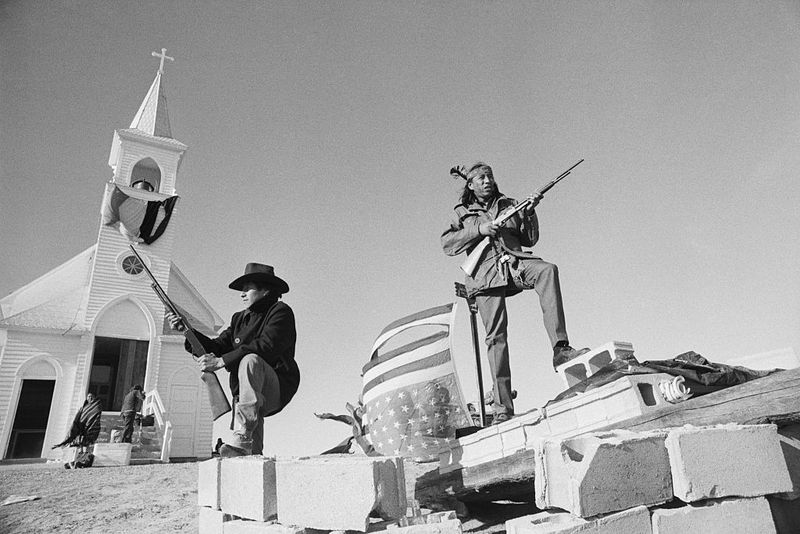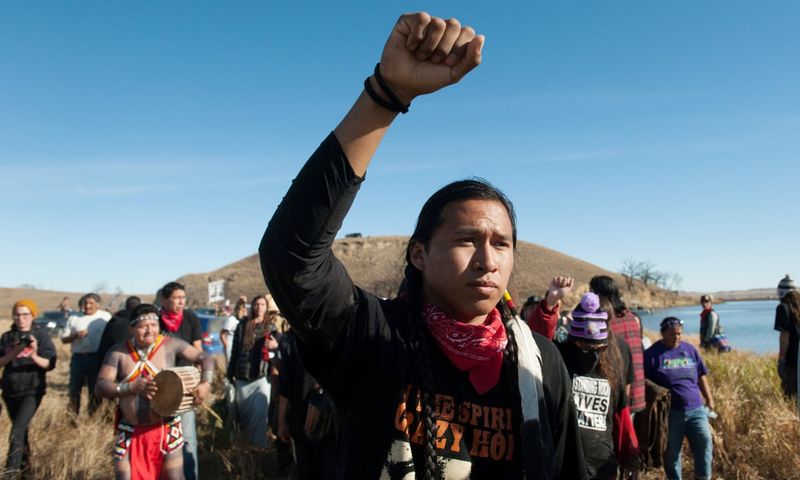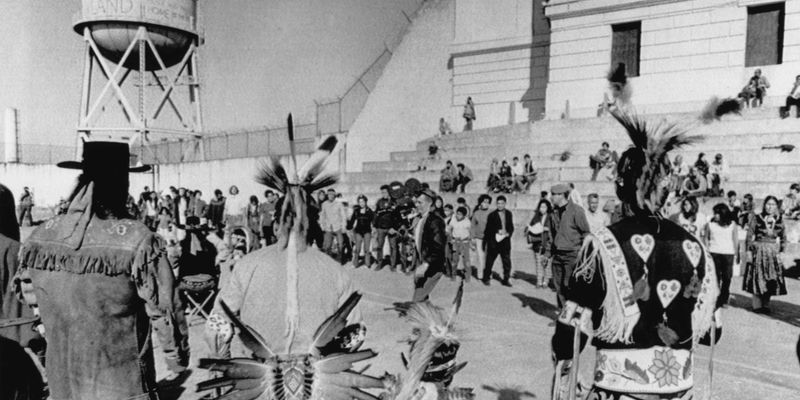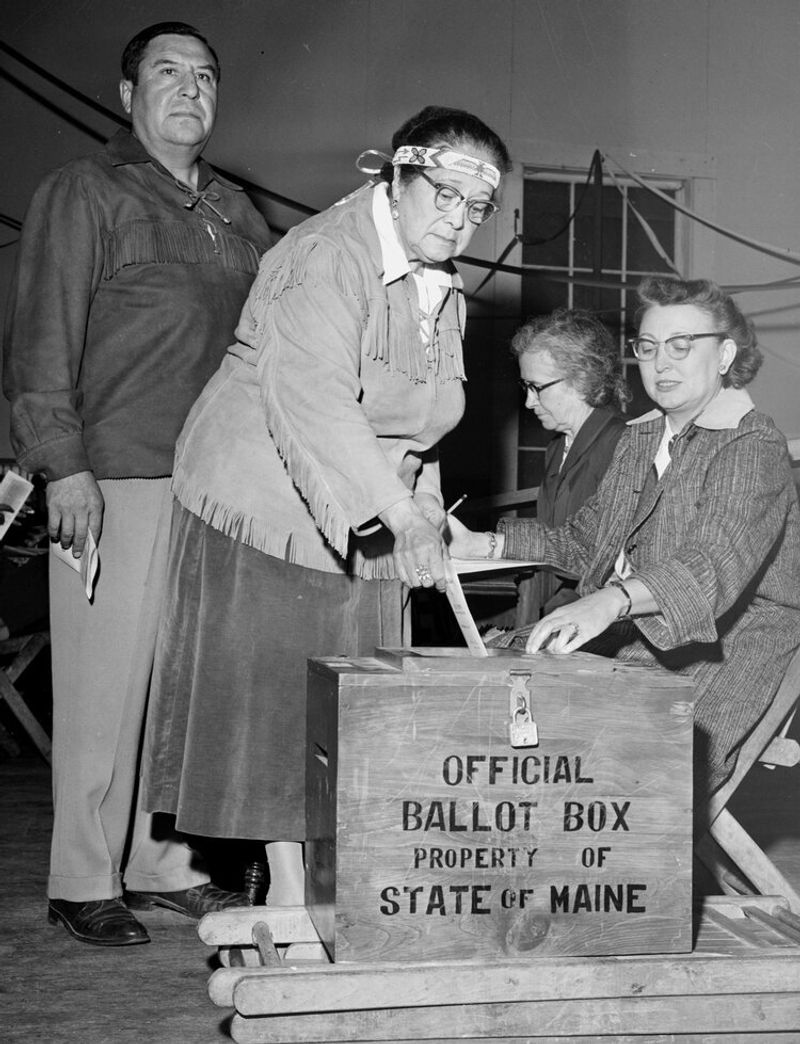Explore a compelling collection of vintage photos that capture the diverse and rich tapestry of Native American life in the 1900s. From the artistry of Navajo weavers to the spiritual ceremonies of the Apache, these images offer a unique glimpse into the traditions, struggles, and resilience of Native American communities. Each photograph tells a story of culture, beauty, and survival, reflecting the profound connection between people and their land. Delve into the portraits, rituals, and daily life that define an era, offering a window into a world of enduring heritage and dignity.
1. A Proud Navajo Weaver, 1905 – Handcrafting Wool Blankets in Arizona
In the heart of Arizona, a Navajo weaver, with skilled hands and a determined spirit, crafts a blanket that tells her people’s stories. The loom is more than a tool; it’s a bridge to her ancestors, a connection to a time-honored tradition.
Each thread she weaves is imbued with meaning, creating patterns that have been passed down through generations. Her work is both art and history, embodying the resilience and creativity of the Navajo people.
The desert sun shines through her workshop, illuminating the vibrant colors of the wool, a testament to her dedication and expertise.
2. Cheyenne Children Playing Near Tipis, Montana Plains (1910)
Laughter echoes across the Montana plains as Cheyenne children play near their family’s tipis. Their games are simple, yet filled with joy and imagination, reflecting a childhood connected to nature.
Amidst the vast open spaces, these young ones weave tales of adventure, their spirits as free as the winds that sweep the plains. The tipis stand as symbols of home and heritage, grounding them in their cultural identity.
These moments of play are cherished, a reminder of the innocence and vitality of youth in a world that is both vast and intimate.
3. Hopi Potter Shaping Clay by Hand, Ancestral Techniques Preserved (1912)
In the quiet of her workspace, a Hopi potter shapes clay with deft hands, each touch a tribute to her ancestors. Her craft is ancient, a legacy of form and function passed down through generations.
The clay responds to her touch, taking shape as bowls and pots that will serve both daily needs and ceremonial purposes. Her artistry is not merely in the finished pieces but in the process itself.
She preserves her people’s history in every curve and line, connecting past to present in the earthy tones of her work.
4. Lakota Elder Telling Stories to Grandchildren, South Dakota (1920s)
Under the wide sky of South Dakota, a Lakota elder gathers his grandchildren around, his voice weaving tales of their ancestors. These stories are not just entertainment; they’re lessons, history, and identity.
The children listen, eyes wide with wonder, as the elder’s words paint pictures of bravery, wisdom, and tradition. Each tale is a thread in the tapestry of their cultural heritage.
Through these storytelling sessions, the elder fosters a deep connection to their roots, ensuring that the wisdom of the past continues to guide future generations.
5. Pueblo Deer Dance Ritual, New Mexico – Sacred Traditions (1907)
In the heart of a New Mexico pueblo, the Deer Dance unfolds, a vivid expression of Pueblo spirituality and tradition. The dancers move with grace, their attire reflecting the sacred nature of the ritual.
The rhythmic drumbeats echo through the plaza, a heartbeat that unites the community in reverence and celebration. Each step and gesture is laden with meaning, paying homage to the natural world and ancestral spirits.
This ancient ceremony continues to thrive, a testament to the enduring power of cultural rituals that bind people to their heritage and the land they cherish.
6. Blackfoot Sun Dance Ceremony, Montana (1911) – A Rare Glimpse
The Sun Dance ceremony stands as a profound spiritual event for the Blackfoot people, embodying sacrifice and renewal. Within a sacred circle, participants engage in rituals that honor their connection to the cosmos and each other.
The ceremony, captured in a rare photograph, reveals the depth of devotion and the communal bond shared among the Blackfoot. Traditional attire and sacred objects enhance the spiritual atmosphere, creating a vivid tableau of cultural unity.
Though outsiders seldom witness this ceremony, its significance resonates, reflecting the enduring spirit of the Blackfoot people.
7. Hopi Kachina Dancers in Masks, Arizona (1925) – Spiritual Guardians
The Hopi Kachina dancers, with their vibrant masks and traditional attire, bring the spiritual world to life in their Arizona village. These masked figures represent the Kachinas, spiritual guardians that embody the elements and ancestral spirits.
Through intricate dances, the performers convey messages of guidance and blessing to their community. The vivid colors and designs of their costumes capture the imagination, drawing in both young and old.
This performance is more than entertainment; it’s a sacred ritual that strengthens the community’s spiritual connection and cultural identity.
8. Crow Fair Parade, Montana (1930s) – Beadwork and Regalia on Display
The Crow Fair Parade is a dazzling display of cultural pride, featuring participants adorned in exquisite beadwork and traditional regalia. This celebration, set against the backdrop of Montana’s vast landscape, is a testament to the Crow people’s rich heritage.
On horseback and on foot, the parade participants embody the spirit of their ancestors, each bead and feather a symbol of identity and unity. The air is filled with the rhythms of traditional music, energizing the crowd.
The parade is not just a spectacle but a profound expression of cultural continuity and resilience.
9. Apache Sunrise Ceremony – Rite of Passage for Young Women (1940s)
The Apache Sunrise Ceremony marks a significant rite of passage for young women, celebrating their transition into womanhood. This sacred event, deeply rooted in tradition, is filled with rituals that honor the young woman’s role within the community.
Family and elders gather to offer blessings and guidance, creating a supportive and nurturing environment. The ceremony involves symbolic dances and teachings that connect the young woman to her cultural heritage.
Through this transformative experience, she gains a deeper understanding of her identity and the responsibilities of adulthood.
10. Cherokee Students at Carlisle Indian School, Pennsylvania (1900) – Forced Assimilation
At the Carlisle Indian School in Pennsylvania, Cherokee students stand in uniform, their expressions a complex mix of resolve and uncertainty. This image captures the reality of forced assimilation, a chapter in history marked by cultural erasure.
The school’s mission was to “civilize” Native children, stripping them of their languages and traditions. Yet, even in uniforms, the students’ identities persist, a silent resistance to the attempts at assimilation.
This photograph serves as a poignant reminder of the resilience of Native communities, who continue to reclaim and preserve their cultural heritage.
11. Navajo Code Talkers Training, WWII (1942) – Unsung Heroes
During WWII, the Navajo Code Talkers emerged as unsung heroes, using their native language to create an unbreakable code. This image captures a training session, where these brave men in military uniforms hone their skills.
Their contribution was vital to the success of Allied operations, yet their story remained largely untold for decades. The code they developed was never deciphered by the enemy, highlighting the unique power of their linguistic heritage.
Today, the Code Talkers are celebrated for their courage and ingenuity, a testament to the enduring spirit of the Navajo people.
12. Sioux Veterans Returning from WWI, South Dakota (1919)
In South Dakota, Sioux veterans return home from the battlefields of WWI, blending military pride with cultural tradition. This image captures their reunion, where traditional attire mingles with military uniforms.
The veterans are celebrated for their service, their bravery a source of pride for their community. Yet, they also face the challenges of reintegration, balancing their warrior legacy with the demands of post-war life.
Their experience reflects the complexities of identity, where service to country intersects with cultural heritage, creating a narrative of resilience and honor.
13. Native American Church Peyote Ceremony (1920s) – Spiritual Resistance
The Peyote Ceremony, central to the Native American Church, represents a form of spiritual resistance and renewal. In this image, participants gather in a sacred circle, united by their quest for spiritual enlightenment.
The ceremony involves the use of Peyote, a sacrament that fosters connection to the divine and the community. Through prayer, song, and ritual, participants seek healing and guidance.
This sacred tradition, often misunderstood, embodies the resilience of Native spirituality, offering a path of resistance and continuity in the face of external pressures.
14. Chief Plenty Coups (Crow) in Full Regalia, Montana (1908)
Chief Plenty Coups, a revered leader of the Crow Nation, stands proudly in full regalia, a figure of dignity and leadership. His attire, rich with feathers and beadwork, symbolizes his status and connection to his people.
In this photograph, Chief Plenty Coups embodies the spirit of his nation, a bridge between tradition and change. His leadership is marked by wisdom and foresight, guiding his people through challenging times.
The image captures more than a leader; it presents a man deeply rooted in his cultural heritage, committed to the well-being and future of his community.
15. Mona, a Hopi Woman, with Traditional Squash Blossom Hairstyle (1910)
Mona, a Hopi woman, stands with poise, her traditional squash blossom hairstyle a symbol of beauty and cultural identity. This image captures her grace and the artistry of Hopi traditions.
The hairstyle, intricate and elegant, reflects Mona’s connection to her heritage, each twist and turn a testament to Hopi craftsmanship. Her attire, adorned with jewelry, complements the style, creating a harmonious blend of tradition and individuality.
Set against the desert backdrop, Mona’s portrait is a celebration of Hopi femininity and resilience, offering a glimpse into a world of timeless beauty.
16. Eskimo Fisherman with Kayak, Alaska (1900s) – Arctic Lifeways
In the icy waters of Alaska, an Eskimo fisherman skillfully navigates his kayak, a vital tool for survival in the Arctic. His traditional gear reflects a life adapted to harsh environments, where skill and knowledge are paramount.
This image captures the essence of a subsistence lifestyle, where fishing is not merely a livelihood but a connection to the natural world. The fisherman’s expertise is evident in his confident handling of the kayak, a symbol of resilience and ingenuity.
The scene is a testament to the enduring spirit of the Eskimo people, thriving in harmony with their environment.
17. Osage Family in Oil Boom Wealth, Oklahoma (1920s) – Contrasts of Fortune
During the oil boom of the 1920s, the Osage family stands amid luxury, their wealth a stark contrast to traditional life. This image captures the opulence that came with oil rights, reflected in their attire and surroundings.
While prosperity brought new opportunities, it also introduced challenges, as the Osage navigated a world of newfound wealth. The family’s expressions reveal a blend of pride and awareness of their unique position.
This photograph offers a glimpse into a transformative era, where cultural identity and modernity intersected, creating a narrative of both fortune and complexity.
18. Paiute Basket Weaver, Nevada (1930s) – Hands Shaping History
With nimble fingers, a Paiute basket weaver shapes history, her hands crafting intricate designs that tell stories of her people. This image captures her focus and artistry in a 1930s Nevada setting.
The baskets, made from natural materials, serve both practical and ceremonial purposes, embodying the connection between the Paiute and their land. Each weave is a testament to generations of knowledge and tradition.
Her work reflects a deep understanding of the natural world, creating pieces that are both beautiful and functional, a legacy woven into every strand.
19. Salmon Fishing at Celilo Falls, Oregon (1909) – Before the Dams
At Celilo Falls, the rhythmic sound of rushing water accompanies Native fishermen as they skillfully cast their nets for salmon. This image captures a way of life that thrived before the construction of dams altered the landscape.
Fishing at Celilo Falls was a communal activity, bringing families and tribes together, each catch a celebration of sustenance and survival. The falls provided an abundant source of salmon, integral to the diet and culture of the region’s Indigenous peoples.
This scene reflects a harmonious relationship with nature, a testament to the enduring traditions of the Columbia River’s Native communities.
20. Navajo Shepherds with Flock, Arizona (1917) – Scenes from the Rez
In the expansive landscapes of Arizona, Navajo shepherds guide their flock across the rugged terrain, a scene that embodies connection and continuity. This image captures the shepherds’ relationship with the land and their livestock, central to Navajo life.
The sheep provide wool for weaving, a vital resource for the community’s artistic and economic pursuits. The shepherds’ vigilance and care reflect a way of life deeply rooted in tradition.
Through their stewardship, they maintain a balance with nature, preserving a way of life that has sustained the Navajo for generations.
21. Pueblo Cornfield Workers, New Mexico (1920s) – Ancient Farming Methods
Under the warm New Mexico sun, Pueblo workers tend to their cornfields, employing ancient methods passed down through generations. This image captures a moment of agricultural continuity, where tradition meets necessity.
The fields are more than a source of sustenance; they represent a connection to the earth and cultural heritage. Each worker plays a role in maintaining this vital link, their labor a harmonious blend of skill and dedication.
This scene of cultivation reflects the resilience and adaptability of the Pueblo people, who thrive by honoring the wisdom of their ancestors.
22. Nez Perce Horsemen, Idaho (1930s) – Keepers of the Appaloosa
The Nez Perce horsemen, mounted on their distinctive Appaloosa horses, ride with pride across the Idaho landscape. This image captures the mastery and bond between rider and steed, a relationship steeped in tradition.
The Appaloosa, known for its spotted coat, is a symbol of Nez Perce heritage, reflecting both beauty and practicality. The horsemen’s skillful riding is a testament to generations of horsemanship.
This scene is more than a display of equestrian prowess; it’s a cultural emblem that honors the legacy of the Nez Perce, keepers of the Appaloosa breed.
23. Tohono O’odham Harvesting Saguaro Fruit, Arizona (1940s)
In the Arizona desert, the Tohono O’odham people engage in the annual harvest of saguaro fruit, a tradition that sustains both body and spirit. This image captures women and men working together, using long poles to gather the ripe bounty.
The saguaro fruit is not only a source of nourishment but also a cultural touchstone, its harvest a time for community gathering and celebration. The desert landscape provides a stunning backdrop to this age-old practice.
Through this ritual, the Tohono O’odham reaffirm their connection to the land, honoring a cycle of renewal and abundance.
24. Wounded Knee Occupation Protest, South Dakota (1973) – Activism Ignited
The Wounded Knee Occupation of 1973 stands as a pivotal moment in Native American activism. This image captures the determination and solidarity of the protesters, gathered under flags and banners.
The occupation, led by members of the American Indian Movement (AIM), highlighted issues of sovereignty and civil rights, drawing national attention to longstanding grievances. The participants, rooted in their heritage, demanded justice and recognition.
This scene of defiance and unity reflects a broader movement for change, igniting a renewed commitment to Native rights and self-determination.
25. Indian Boarding School Classroom, Nebraska (1910) – Erasing Culture
Inside a Nebraska boarding school classroom, Native students sit at desks, surrounded by books and the trappings of Western education. This image captures the stark reality of cultural assimilation, where traditional identities were systematically suppressed.
The classroom, a tool for “civilization,” sought to erase Indigenous languages and customs, replacing them with a foreign curriculum. Yet, even in uniformity, the students’ resilience shines through, a quiet defiance against erasure.
This photograph serves as a somber reminder of a painful history, yet also a testament to the enduring spirit of Native cultures that continue to thrive.
26. Dakota Access Pipeline Protests, Standing Rock (2016) – Modern Resistance
In 2016, the Dakota Access Pipeline protests at Standing Rock captured worldwide attention, symbolizing modern resistance to environmental and cultural threats. This image shows protesters united in defiance, with flags and signs held high.
The protest, led by Native tribes and environmental allies, highlighted the ongoing struggle for sovereignty and environmental protection. The participants drew on their cultural heritage, standing firm in their commitment to the land and its preservation.
This movement represents a continuation of Native activism, bridging past struggles with contemporary challenges, and advocating for a sustainable future.
27. Alcatraz Occupation by ‘Indians of All Tribes,’ California (1969)
The occupation of Alcatraz Island in 1969 by ‘Indians of All Tribes’ marked a bold statement in the fight for Native American rights. This image captures activists asserting their presence, surrounded by the iconic prison structure.
The occupation emphasized issues of land rights and sovereignty, drawing attention to the injustices faced by Native communities. Banners and signs proclaimed their message, resonating with a broader audience.
This act of defiance became a catalyst for change, inspiring subsequent movements and highlighting the resilience and determination of Indigenous peoples to reclaim their rights and identity.
28. Native American Voting Rights March, Arizona (1948) – Fighting for Citizenship
In 1948, the fight for Native American voting rights culminated in a march through Arizona, a significant step towards citizenship and equality. This image captures marchers with banners and signs, their resolve evident in every step.
The march represented a broader struggle for civil rights, challenging legal barriers that denied Native Americans full participation in democracy. The leaders, drawing on their heritage, pushed for change that would echo across generations.
This event marked a turning point, highlighting the ongoing battle for rights and recognition, a testament to the enduring spirit of justice and equality.
